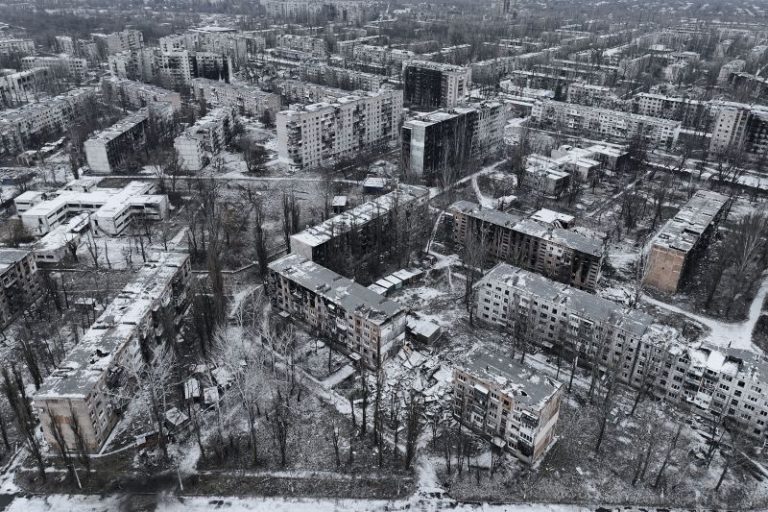As the second anniversary of Russia’s full-scale invasion of Ukraine approaches, and with a new armed forces leadership team in place in Kyiv, Ukraine’s soldiers find themselves on the defensive across the eastern front line.
A series of reports on social media and on national television over the weekend paint a picture of Russians continuing to throw large numbers of men into battle, and stepping up further their use of drones, which it is now clear are one of the key weapons on the battlefield.
Avdiivka, to the northwest of Donetsk city, remains the scene of some of the heaviest fighting as Russian forces continue their push from the north into the center of town.
The DeepState mapping site has shown a series of Russian advances in recent days and now puts Moscow’s fighters in control of part of the railway line just north of the town’s station.
Ukraine’s commander of southern forces, Oleksandr Tarnavskyi, said Saturday that his logistics teams were still able to get supplies into the town and that he was rotating fresh fighters into the battle as well as setting up additional firing positions.
Even so, the DeepState mapping site suggests Russian forces are perhaps no more than several hundred meters away from the main supply route into town.
Serhii Tsekhotskyi, an officer with the 59th Separate Motorized Infantry Brigade, told Ukrainian television that Russia was deploying large numbers of troop into the battle for Avdiivka. Many were being killed, he insisted.
“They do not spare their people, so we have a lot of work to do,” he said.
He also drew attention once again to the prevalence of drones, reporting some 70 bombs dropped from Russian UAVs on brigade positions in the town in one day alone.
“Their stock [of drones] is being replenished, they are constantly improving their UAVs, and are also using electronic warfare,” he said.
Both sides are locked in a technology competition with each other, developing ever more sophisticated drones, as well as refining the jamming capabilities designed to disable incoming UAVs.
Reports from Russian military bloggers paint a similar picture of slow but steady gain for Russia’s forces inside Avdiivka, though they stress some of the town’s key locations, not least the massive coke plant on the northwestern edge of town, remain in Ukrainian hands.
“Military officers on the ground report there is no need to rush with victory speeches,” one such blogger, Boris Rozhin, wrote.
In much the same way that Bakhmut acquired huge symbolic importance a year ago, as Russian forces closed in on the city, destroying it in the process, so Avdiivka appears to have adopted a similar significance.
Lying just a few kilometers north of Donetsk airport, captured by Russian forces in early 2015 after months of periodically heavy fighting, Avdiivka has been firmly in Moscow’s crosshairs ever since. With Russia’s presidential election just a few weeks away, its possible capture has taken on even greater value.
A challenge for the new chief
What to do about Avdiivka is arguably the most pressing challenge facing Ukraine’s new army chief, Oleksandr Syrskyi, appointed Thursday to give the war a new focus.
As Commander of Land Forces, Syrskyi was seen as the key driver behind Ukraine’s decision to defend Bakhmut to the last, rather than execute an earlier withdrawal, as the US and other allies had reportedly been urging. The decision to keep fighting in the face of overwhelming Russian firepower earned him a reputation as a man willing to take high losses among his soldiers.
In his first statement since being appointed Commander-in-Chief, he appeared, at least in part, to acknowledge a need to address that, saying, “The lives and health of servicemen have always been and remain the main value of the Ukrainian army. Therefore, maintaining a balance between combat missions and the restoration of units and subunits with intensified education and training of personnel remains as relevant as ever.”
However, Syrskyi is under pressure from Ukraine’s political leadership to come up with a new plan that avoids “stagnation” on the battlefield, while at the same time not pushing for too many new conscripts, as a new mobilization bill makes its way through parliament.
His predecessor, Valerii Zaluzhnyi, was dismissed in part for describing the war as being in a “stalemate” situation after the much-anticipated counteroffensive last year failed to deliver gains of any note.
President Volodymyr Zelensky was also irritated by Zaluzhnyi’s suggestions he needed a huge mobilization drive to turn things around. Though the army chief has said he did not put a number on it, he became associated with an idea that half a million new soldiers were needed.
Regardless of how many draftees Syrskyi ends up requesting, evidence from multiple frontline locations continues to suggest Russia’s superior troop numbers are making a difference.
East of Kupiansk and the Oskil river, along the northernmost stretch of the battle, an army spokesman told Ukrainian television on Saturday that Russian forces were pressing.
“The enemy continues to move its reserves to replace those previously lost … The enemy is deploying Storm Z units [soldiers recruited from prison] and motorized infantry units, supported by artillery and drones. They are trying to move forward,” the spokesman said.
Altogether, Russia had 42,000 men stationed in the area – though not all at the frontline – along with 500 tanks and infantry fighting vehicles, he added.
Also under heavy pressure is Chasiv Yar, a town about 15 kilometers west of Bakhmut. Again, a local Ukrainian commander reported Russians attacking with “a huge force of personnel.”
The army spokesmen also said the other big Ukrainian shortcoming at present – low ammunition stocks – was being keenly felt.
Russia’s forces attacking Chasiv Yar from the flanks enjoyed a “several-fold advantage in the number of shellings. We need more shells, thousands and thousands of shells, especially 155mm ones,” he told national television.

